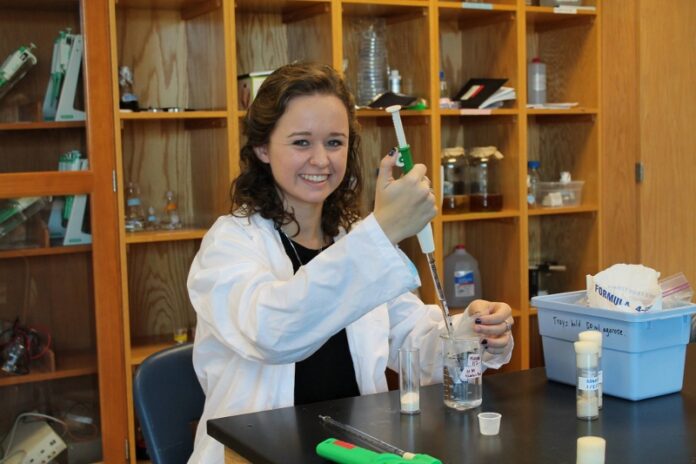
At the Roanoke Valley Governor’s School for Science and Technology, students are charged each year with carrying out a science fair project. Occasionally a student gets so interested in her work that it becomes a multi-year commitment, and that is what happened this year with RVGS/Patrick Henry High School senior Mason Wheeler.
Last year Wheeler studied the effect of 5-N-ethyl-glutamine – an amino acid – on the mobility of Drosophila melanogaster (fruit flies) that had been genetically-engineered to have the disease ALS, or amyotrophic lateral sclerosis. This year she is testing more of the same mutant fruit flies to investigate the effect of ascorbic acid, or Vitamin C, on their oxidative stress.
“Oxidative stress is the bodily function thought to cause the body to age,” said Wheeler, “and it occurs more rapidly in familial ALS patients. I want to know if my treatment can increase patients’ mobility while decreasing their oxidative stress. Basically, I’m hoping to replicate last year’s success on a different bodily function.”
Amyotrophic lateral sclerosis, known as ALS or Lou Gehrig’s disease, is a progressive neurodegenerative disease that affects nerve cells in the brain and the spinal cord. The word “amyotrophic” literally means “no muscle nourishment”, and as ALS progresses, the ability of the brain to initiate and control voluntary muscle movement is lost.
ALS kills motor neurons, and people affected by the disease may lose the ability to talk, eat, move, and even breathe. ALS affects more than 450,000 people worldwide, and the average life expectancy of a person diagnosed with ALS is two to five years.
Familial or genetic ALS is inherited and accounts for just 10% of all cases. Wheeler is specifically studying this “under-observed” group.
Like most research projects at the Governor’s School, Wheeler’s is complicated. For the project, she created an ascorbic acid solution, exposed larvae to the solution, allowed the adults to reproduce, and then tested their offspring’s mobility using a crawling assay. To test oxidative stress, she placed the same offspring onto a petri dish containing a non-nutrient agar, which forced the larvae to starve, and then she recorded the length of time it took for each larvae to perish.
As a Governor’s School student Wheeler has had complete access to the extensive Gov. School labs, and she has been able to complete her entire project on-site. She is now in the process of data analysis and is hopeful that her efforts will be a stepping stone in improving mobility in sufferers of this debilitating disease.
To find out how the project turns out, and to talk with the other 268 young scientists about their own exciting, innovative experiments, attend Roanoke Valley Governor’s School’s Student Project Forum. Project Forum is a free, open-to-the-public event that will take place from 1:30-3:00 PM on Saturday, January 30th, in the Patrick Henry High School cafeteria.
To take the Ice Bucket Challenge, the ALS awareness campaign that went viral in the summer of 2014, visit http://www.alsa.org/fight-als/ice-bucket-challenge.html; #EveryAugustUntilACure.
To learn more about Roanoke Valley Governor’s School, a half-day regional public STEM school for motivated students in grades nine through twelve, please visit the school’s website at www.rvgs.k12.va.us or contact the school’s director, Dr. John Kowalski, or the school’s guidance counselor, Kathy Sebolt, at 540.853.2116.
-Regina Carson
